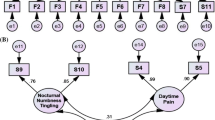Abstract
The potential for predicting membership in a Carpal Tunnel Syndrome group (CTS) vs. a non-CTS group was evaluated for five psychological variables (i.e., life events stress, perceived stress, self-management habits, cognitive self-control skills, and lifestyle organization) and three physical variables (i.e., general physical symptoms, suspected medical risk for CTS, and generic musculoskeletal problems). The subjects included 50 pairs of workers, with each pair having one worker who had CTS and the other who had not. A logistic regression analysis indicated that five of the measures (three psychological and two physical) were significant single model predictors of membership in CTS and non-CTS groups. The most efficient multifactor model in predicting CTS appeared to be a combination of measures reflecting generic musculoskeletal problems and lifestyle organization.
Similar content being viewed by others
References
Bureau of Labor Statistics. Occupational injuries and illnesses in the United States by industry, 1989: U.S. Department of Labor, Bulletin 2379, U.S. Government Printing Office, Washington, D.C., 1991.
Nathan PA, Meadows KD, Doyle LS. Occupation as a risk factor for impaired sensory conduction of the median nerve at the carpal tunnel.J Hand Surg 1988; 13B: 167–170.
Cohn L, Lowry RM, Hart S. Overuse syndromes of the upper extremity in interpreters for the deaf.Orthopedics 1980; 207–209.
Meals RA, Payne W, Gaines R. Functional demands and consequences of manual communication.J Hand Surg 1988; 13A: 686–691.
Ditmas DM. Patterns of carpal tunnel syndrome.Hand Clin 1993; 9: 241–261.
Arndt R. Work pace, stress, and cumulative trauma disorders.J Hand Surg 1987; 12A: 866–869.
Lutz G, Hansford T. Cumulative trauma disorder controls: The ergonomics problem at Ethicon, Inc.J Hand Surg 1987; 12A: 863–866.
Murphy LR, Hurrell JJ. Machine pacing and occupational stress. In: Schwartz RM, ed.New developments in occupational stress. Cincinnati: UCLA Conference Proceedings, DHEW (NIOSH), 1979, pp. 10–20.
Herrick RT, Herrick SK. Thermography in the detection of carpal tunnel syndrome and other compressive neuropathies.J Hand Surg 1987; 12: 943–949.
Nathan PA, Keniston RC. Carpal tunnel syndrome and its relation to general physical condition.Hand Clin 1993; 9: 253–261.
Thurston AJ, Krause BL. The possible role of vascular congestion in carpal tunnel syndrome.J Hand Surg 1988; 13B: 397–399.
Cannon LJ, Bernacki EJ, Walter SD. Personal and occupational factors associated with carpal tunnel syndrome.J Occup Med 1981; 23: 255–258.
Fuchs PC, Nathan PA, Myers LD. Synovial histology in carpal tunnel syndrome.J Hand Surg 1991; 16A: 753–758.
Holmes TH, Rahe RH. The social readjustment rating scale.J Psychosom Res 1967; 11: 213–218.
Cohen S, Kamarck T, Mermelstein R. A global measure of perceived stress.J Health Soc Behav 1983; 24: 385–396.
Adams HE, Feuerstein M, Fowler JL. Migraine headache: Review of parameters, etiology and intervention.Psychol Bull 1980; 87: 217–237.
Feuerstein M, Bush C, Corbisiero T. Stress and chronic headache: A psychophysiology analysis of mechanisms.J Psychosom Res 1982; 26: 167–182.
Feuerstein M, Carter RL, Papciak AS. A prospective analysis of stress and fatigue in recurrent low back pain.Pain 1987; 31: 333–344.
Feuerstein M, Sult S, Houle M. Environmental Stressors and chronic low back pain: Life events, family & work environment.Pain 1985; 22: 295–307.
Williams RL, Moore CA, Pettibone TJ, Thomas SP. Construction and validation of a self-report scale of self-management practices.J Res Pers 1992; 26: 216–234.
Brandon JE, Oescher J, Loftin JM. The self-control questionnaire: An assessment.Health Val 1980; 14: 3–9.
Rosenbaum M. A schedule for assessing self-control behaviors: Preliminary findings.Behav Ther 1980; 11: 109–121.
Nathan PA, Keniston RC, Myers LD, Meadows KD. Obesity as a risk factor for slowing sensory conduction of the median nerve in industry: A cross-sectional and longitudinal study involving 429 workers.J Occup Med 1992; 34: 379–383.
Coddington RD. The significance of life events as etiologic factors in diseases of children: A survey of professional workers.J Psychosom Res 1972; 16: 7–18.
Paykel EG. Recent life events and clinical depression. In: Gunderson EKE, Rahe RH, eds.Life stress and illness. Springfield: Charles C. Thomas Publishing, 1974: 134–163.
Rahe RH. The pathway between subjects' recent life changes and their near-future illness reports and methodological issues. In: Dohrenwend BS, Dohrenwend BP, eds.Stressful life events: Their nature and effects. New York: John Wiley & sons, 1974, pp. 73–86.
Williams RL, Long JD.Manage your life: Instructor's resource manual with test items (4th Ed.). Boston: Houghton Mifflin Company, 1991.
Cohen S, Hoberman HM. Positive events and social supports as buffers of life change stress.J Appl Psychol 1983; 13: 99–125.
Feuerstein, M. Workstyle: Definition, empirical support and implications for prevention, evaluation and rehabilitation of occupational upper extremity disorders. In: Moon SD, Sauter S, eds.Beyond biomechanics: Psychosocial factors in office-related cumulative trauma disorders. London: Taylor and Francis (in press).
Author information
Authors and Affiliations
Rights and permissions
About this article
Cite this article
Vogelsang, L.M., Williams, R.L. & Lawler, K. Lifestyle correlates of Carpal Tunnel Syndrome. J Occup Rehab 4, 141–152 (1994). https://doi.org/10.1007/BF02109970
Issue Date:
DOI: https://doi.org/10.1007/BF02109970




